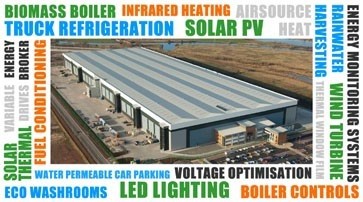Are your energy bills as low as they could be?
 In today’s world every option to save money and more importantly the world we live in must be considered, in my view, by everyone.
In today’s world every option to save money and more importantly the world we live in must be considered, in my view, by everyone.
This article by Dave Skeels of Complete Eco explains what to consider when taking a serious look at this subject and its benefits.
Are your energy bills as low as they could be? There are the options you may not even realise for reducing commercial energy use
If you run a distribution centre, you already know about the significant associated running costs and a major part of that is likely to be energy bills. In the coming years, all businesses face two major challenges when it comes to energy: cost and supply.
The current price of energy has doubled in the last 6 years. This is even more concerning when we consider that this trend is set to continue, with forecasts for further increases of anything from 6-10% annually.

How to get bills down? Simple, first reduce the cost …
Most companies will target the energy provider as a first stop and negotiate better rates of supply for electricity and gas. A studious move, especially effective if you use a broker with a strong collective bargaining power. We regularly see companies reduce bills by over 10% for the price of a phone call. Another tactic for lowering the cost of energy is to generate your own. Most commercial sheds have ideal opportunities for Solar PV or Thermal on the roof or land nearby for Wind Turbines, Airsource or Groundsource heating and anyone using a boiler can switch to Biomass. Payback periods can vary depending on size and use but, with a general window of 7 to 10 years, it’s an ideal scenario for any company that’s in it for the long-term.
… then reduce the consumption
Energy management is one of the fastest developing areas in the market with new products launching every month and it can be hard to keep up. There’s a huge range of measures to look at and many of them are answers to questions you didn’t even know to ask.
Reduction measures usually have an edge over renewables, as they are lower cost, easy to implement and usually demonstrate much shorter payback periods.
Some, such as LED lighting, are already well-established. For any businesses running office lighting or high-wattage lights, such as high bays, exterior floodlights or car parks, the savings can be significant.
There are numerous technologies available for space heating and also cooling from Infrared Radiant Heaters providing low-cost ultra-efficient zoned heating to Free From Air Evaporative Cooling technology. Another superb technology is a Thermostat Optimisation system that demonstrates big savings by preventing cold-storage areas from calling on the refrigeration plant unnecessarily.
Boilers and heating systems can be made vastly more efficient through use of brand-new innovations such as Magnetic Fuel Conditioning and Heating System Additives, each of which achieving savings of up to 10% or more against heating bills.
The latest thinking in the war against energy wastage is to control equipment more accurately. Energy Monitoring Systems show where electricity is being used and the real cost of leaving equipment on unused. Boiler Controls and Building Management software can automatically run HVAC systems for you, adjusting fuel use in real time.
On a broader scale, Voltage Optimisation control can ensure that premises aren’t drawing more units of electricity than they actually need to run electrical equipment.
We can even improve efficiency on the road, with technology to reduce the energy used by refrigerated lorries.
Covering the costs
Needless to say the barrier to implementing any or all of these technologies is the up-front capital expenditure. Although some of the reduction technologies are low cost in themselves, the ideal scenario, especially with bigger projects, is to make any measures cost-positive from day one. Funding, usually through asset finance, can be the answer. If the cost of the loan is less than the savings then installations become instantly profitable, regardless of payback periods. For renewables though, the new trend is power purchase agreements.
Your roof could be an undiscovered gold-mine
Most large commercial units have roof space that does nothing more than keep out the rain. By leasing the space over a fixed period to a solar installation company, you could not only generate revenue from the lease but also take advantage of an option to purchase the power generated at a rate far below the main utility suppliers and, at a rate protected against big price hikes… for no capital expenditure!
It almost seems too good but it’s true. Within reason, any type of commercial shed can take advantage of a low cost, protected energy supply that will last at least 20 years.
Bring in the experts
With so many options and opportunities available, you need to form an energy strategy to get the best out of the market and that’s where Complete ECO can help. We keep up with all the latest developments and advise you on what will work for you and your business. The right approach can reduce energy bills by 50% or more, so the real question is: can you afford to wait any longer?
For more information, visit our website www.completeeco.com or call now on 0844 824 3527.

